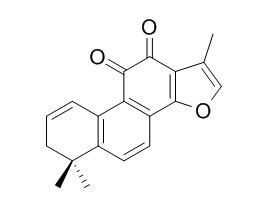1,2-Didehydrotanshinone IIA
1,2-Didehydrotanshinone IIA shows inhibitory effects against acetyl- (AChE) and butyrylcholinesterase (BChE). It also possesses metal-chelation capacity.
Inquire / Order:
manager@chemfaces.com
Technical Inquiries:
service@chemfaces.com
Tel:
+86-27-84237783
Fax:
+86-27-84254680
Address:
1 Building, No. 83, CheCheng Rd., Wuhan Economic and Technological Development Zone, Wuhan, Hubei 430056, PRC
Providing storage is as stated on the product vial and the vial is kept tightly sealed, the product can be stored for up to
24 months(2-8C).
Wherever possible, you should prepare and use solutions on the same day. However, if you need to make up stock solutions in advance, we recommend that you store the solution as aliquots in tightly sealed vials at -20C. Generally, these will be useable for up to two weeks. Before use, and prior to opening the vial we recommend that you allow your product to equilibrate to room temperature for at least 1 hour.
Need more advice on solubility, usage and handling? Please email to: service@chemfaces.com
The packaging of the product may have turned upside down during transportation, resulting in the natural compounds adhering to the neck or cap of the vial. take the vial out of its packaging and gently shake to let the compounds fall to the bottom of the vial. for liquid products, centrifuge at 200-500 RPM to gather the liquid at the bottom of the vial. try to avoid loss or contamination during handling.
The Japan Society for Analytical Chemistry2017, 613-617
Phytomedicine.2024, 122:155065.
J Plant Biochem.Biotech.2024, 33:353-366.
Biomed Pharmacother.2022, 156:113929.
Molecules.2022, 27(21):7643.
J of Archaeological Science:Reports2024, 53:104298
Plants (Basel).2020, 9(11):1555.
Iranian J. Pharm. Res.2021, 20(4):59-70
Anticancer Res.2024, 44(3):1033-1044.
Phytomedicine.2024, 155760.
Related and Featured Products
Phytochemistry. 2017 Jan;133:33-44.
Selective in vitro and in silico butyrylcholinesterase inhibitory activity of diterpenes and rosmarinic acid isolated from Perovskia atriplicifolia Benth. and Salvia glutinosa L.[Pubmed:
27817931 ]
Cholinesterase inhibition is one of the most treatment strategies against Alzheimer's disease (AD) where metal accumulation is also strongly associated with pathology of the disease.
METHODS AND RESULTS:
In the current study, we assessed inhibitory effect against acetyl- (AChE) and butyrylcholinesterase (BChE) and metal-chelating capacity of twelve diterpenes: arucadiol, miltirone, tanshinone IIa, 1-oxomiltirone, cryptotanshinone, 1,2-didehydromiltirone, 1,2-Didehydrotanshinone IIA, 1β-hydroxycryptotanshinone, 15,16-dihydrotanshinone, tanshinone I, isotanshinone II, 1(S)-hydroxytanshinone IIa, and rosmarinic acid, isolated from Perovskia atriplicifolia and Salvia glutinosa. The compounds were tested at 10 μg/mL using ELISA microtiter assays against AChE and BChE. QSAR and molecular docking studies have been also performed on the active compounds. All of the compounds showed higher [e.g., IC50 = 1.12 ± 0.07 μg/mL for 1,2-didehydromiltirone, IC50 = 1.15 ± 0.07 μg/mL for cryptotanshinone, IC50 = 1.20 ± 0.03 μg/mL for arucadiol, etc.)] or closer [1,2-Didehydrotanshinone IIA (IC50 = 5.98 ± 0.49 μg/mL) and 1(S)-hydroxytanshinone IIa (IC50 = 5.71 ± 0.27 μg/mL)] inhibition against BChE as compared to that of galanthamine (IC50 = 12.56 ± 0.37 μg/mL), whereas only 15,16-dihydrotanshinone moderately inhibited AChE (65.17 ± 1.39%). 1,2-Didehydrotanshinone IIA (48.94 ± 0.26%) and 1(S)-hydroxytanshinone IIa (47.18 ± 5.10%) possessed the highest metal-chelation capacity.
CONCLUSIONS:
The present study affords an evidence for the fact that selective BChE inhibitors should be further investigated as promising candidate molecules for AD therapy.
Nat Prod Commun. 2015 Jul;10(7):1149-52.
Isolation and Fast Selective Determination of Nor-abietanoid Diterpenoids from Perovskia atriplicifolia Roots Using LC-ESI-MS/MS with Multiple Reaction Monitoring.[Pubmed:
26410997]
In the first part of this study we extracted, isolated, and identified the main diterpenoid constituents from the roots of a Central Asian medicinal and ornamental plant--Perovskia atriplicifolia Benth.
METHODS AND RESULTS:
Eight major nor-abietanoid pigments were obtained using NP silica gel column chromatography and preparative RP-HPLC: cryptotanshinone, 1-hydroxycryptotanhinone, miltirone, 1-oxomiltirone, tanshinone IIa, 1,2 didehydrotanshinone IIa, 1,2 didehydromiltirone, the non-quinone diterpenoid - arucadiol, as well as rosmarinic acid as a main phenolic compound. Secondly, we used the obtained compounds for fast and selective determination of the main diterpenes present in P. atriplicifolia root extract. After extraction with n-hexane, the quantitative analysis was carried out by LC-MS/MS with a triple quadrupole (qQq) mass detector without any prior clean-up step. Identification of the diterpenes was confirmed by multiple reaction monitoring (MRM) using the most representative transitions from the precursor ions, while the most sensitive transitions were used for quantification in a 19-minute run. Most of the isolated and analyzed compounds had not been previously reported from this species.
CONCLUSIONS:
This easily cultivated plant is a promising source of several pharmacologically valuable abietanoid diterpenoids.



